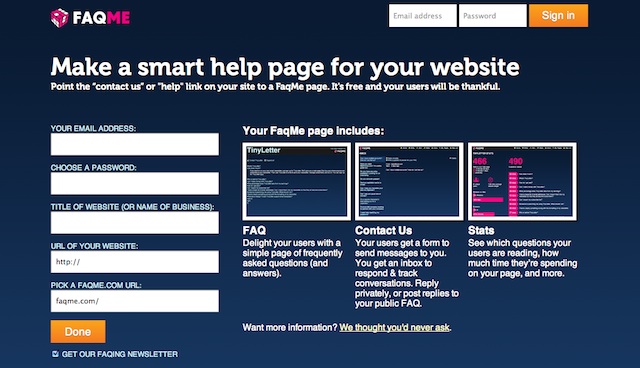A FAQ – frequently asked questions – should be an important part of your website or service. They speed up the help for your users by not waiting for a response from support and thus save time by not having to repeatedly answer the same questions.
Unfortunately, many websites and services have FAQs that are, well, to be frank, unusable. They’re either too long, don’t actually feature real questions, and are in no way helpful or useful.
Not to worry, though – just because many FAQs suck doesn’t mean yours has to. If you’re looking for some simple tips – rather than something ultra-specific and niche – here are 7 best help & FAQ usability tips.

1. Include actual frequently-asked questions
If you’re going to include a FAQ, make sure it’s actual frequently-asked questions – otherwise, your FAQ is a FAQ’ing failure. None of these patronizing fake questions that no real user would ask. It’s called Frequently Asked Questions, not Fictitiously Asked Questions.
If you notice repeated questions asked of you via email/social networks/etc., add that to the FAQ along with your answer. Keep track, collect, and add your users’ questions to your FAQ on a constant basis. It really is that simple.
2. Speed up getting those questions by asking
So you want a FAQ sooner than later, but you’re fairly new, and not many questions have been asked yet. What’s a website/service owner to do? Again, avoid the temptation to add fake questions. Instead, ask your users directly.
Send a message out to your mailing list. Write a post on your blog. Ask on social media. Ask users and users that have already emailed you. Or however else. The point is, just ask.
How? Be upfront. Say you’re trying to make a helpful FAQ, and could the user give a few questions he/she had and wasn’t able to find the answer to on your website?
3. Keep it simple
No one likes a long page filled with jumbled paragraphs. It’s really annoying searching through stuff like that to find an answer. Rather than stuffing as many questions and answers as possible onto a single page, consider simplifying. In other words, make it skim-able so users can quickly find a solution rather than getting frustrated or emailing you.
It could just be breaking up your FAQ into categories. This is so a user can choose the topic and then see possible solutions only pertaining to the issue at hand. Or it can be an old-fashioned editing session to reduce the word count and redundancies, so the entire FAQ is more readable.
Whatever it takes, keep your FAQ simple. Your users will be thankful they quickly skimmed and found a solution rather than getting frustrated or, worse – emailing you with a question you already answered in your FAQ (gasp).
4. Organize your FAQ in what makes most sense
Not all FAQs are created equal. What kind of questions are you answering? If it’s all related to one general topic, then you don’t need categories making the organization more complex than it needs to be. If you have various topics – such as account creation, tech support, content submitter vs. consumer actions – then it’d make sense to categorize the questions and answers first.
A person looking at how to submit content isn’t currently interested in solutions for the consumer side of your website/service. Tech support doesn’t belong in the same place as how to share content with friends. And so forth.
Also, consider not only categorizing but how to present the categories. If you have a lot of categories and sub-categories, then perhaps a sidebar with dropdowns makes the most sense. So that a user can quickly find the right topic, click on it, and the questions and answers pertaining to it appear in the main area.
Or if you have a lot of questions that pertain to more or less the same topic, you could have the top 10 most frequently asked questions appear along with a search bar to find and access more answers.
That’s just two examples. The point is to consider not only the categories but how to present their layout and user interface-wise.
5. Consider calling your FAQ something else
Depending on your website’s audience, consider renaming your FAQ to something else. The term FAQ is sometimes associated with bewildering messes of questions and answers that are hard to figure out and find a solution in.
This is obviously your call since you’d know your audience best. Some considerations are “Help,” “Support,” and “Solutions.”
6. Reassure users their questions aren’t stupid
No one enjoys feeling like an idiot. That’s why some people don’t speak up with their questions – for fear the room will laugh at the “stupid question.” Reassure your users that their questions aren’t stupid and are perfectly normal.
You don’t necessarily need to do anything out-of-the-ordinary. Just include questions in your FAQ which you might think are obvious, but someone has asked. Then when another user has that question and starts questioning if they can’t figure something out, seeing that question in the FAQ will reassure them their question isn’t stupid.
They’ll feel happier and more confident using your website/service, and a happy user/customer is the best PR and marketing for you.
7. Place your FAQ where it’s easy to access
Make the help your user is seeking easy to get. None of this “inserting into the footer in a tiny font” nonsense. Where are your main navigation items? Probably at the top of your website or interface. Throw a Help/FAQ/etc. Link/button there as well.
Think about it: as a user, the longer it takes for you to find a solution, the more likely you’ll get frustrated and just find another website/service. Don’t make users hunt for your FAQ. Make it as easy to access as any other main navigation item like About, Contact, or whatnot.
Tool for Simple Help & FAQ Creation
Faqme is a cheekily-titled web-based tool for quickly creating a usable help & FAQ page for your website. Granted, if you have a more complex Amazon-like FAQ to create, FaqMe won’t cut it.

But for simpler FAQ page creation, FaqMe can save you time so you can focus on categorizing and inserting the right questions rather than figuring out the layout or design.
(And no, this isn’t some paid shoutout, as it sometimes seems so when only one app or service is featured rather than a roundup of services. I simply recently stumbled on FaqMe, and while writing this list of FAQ tips, it made sense to feature some tool that can help in FAQ creation and make this article hopefully even more actionable and useful.)
Related Topics
Top
